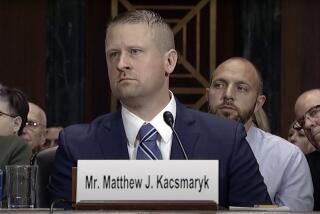The birth control divide
The students were giggling, trading gossip, but they stopped when Maria Elena Chavez dumped her stash of teaching aides on the table: Cola-flavored condoms. A cervical cap. An IUD. A diaphragm.
As the room quieted, Chavez unrolled a condom and stretched it over her hand.
“Many men will say they don’t fit, but you can see how much this can stretch,” she said. The students nodded, murmuring in surprise. One hand shot up, then another.
“Do they come in different sizes?”
“Should we put water in them first, to test them?”
“Can you use two at once for extra protection?”
These students in East L.A. were not inexperienced teens. They were women in their 30s and 40s, many of them married, all of them mothers -- and, yet, still uncertain how to protect themselves from pregnancy.
They are far from alone.
A new statistical analysis, published this month, shows that poor and uneducated women have fallen farther behind their more affluent peers in their ability to control fertility and plan childbearing.
The nation’s overall rate of unintended pregnancies held steady from the mid-1990s through 2001, the most recent year such data is available. But that stability masked huge disparities between demographic groups, according to the new analysis by the Guttmacher Institute, a research group affiliated with Planned Parenthood.
Teenagers, college graduates and women in the middle or upper class dramatically reduced unintended pregnancy and abortion rates. Among poor women, though, the unplanned pregnancy rate jumped nearly 30%.
As a result, poor women are now four times more likely to face an unintended pregnancy than those who are better off. They’re also three times more likely to get an abortion.
Analysts at the Guttmacher Institute blame the problem largely on a lack of access to affordable contraception. Prominent Democrats echo that theme, arguing that the nation has a moral responsibility to improve access, both to ensure women’s health and to bring down the abortion rate.
“We have to make sure families have more options,” said Sen. Patty Murray (D-Wash.). “If you don’t have the resources ... they don’t get the services.”
But public health experts say more funding is not necessarily the answer.
California spends $124 on family planning for every woman in need, more than any other state except South Carolina and Alabama. The state’s Family PACT program offers teens and low-income couples easy access to free or affordable birth control. Yet California has one of the highest abortion rates in the country -- the same rate as Nevada, which spends only $32 per woman in need, according to the Guttmacher Institute.
Nebraska presents the opposite scenario. The Guttmacher Institute ranks it worst in the nation at helping poor women avoid unintended pregnancies. Yet Nebraska has one of the country’s lowest abortion rates.
On a national level, the jump in unplanned pregnancies came even as the federal government began offering to cover 90% of the cost if states would subsidize birth control for low-income women through Medicaid. At least 23 states, including California, have set up such programs. Details vary, but most offer exams and contraception to women earning up to twice the federal poverty level.
Former U.S. Surgeon General David Satcher applauds such subsidies, but warns that free birth control alone won’t bring down the unintended pregnancy rate. He calls instead for broad social change: Low-income women must build self-esteem and confidence in a better future. Only then, he said, will they be motivated to protect themselves. “To gain control of these issues, you really have to get beyond sex,” said Satcher, who worked in the Clinton administration. “You have to dig deep and look at what’s happening in their lives, their relationships and their minds.”
Laura Gaydos came to a similar conclusion after holding recent focus groups with low-income women of all ages and races in cities across Georgia. A health researcher at Emory University in Atlanta, Gaydos said many of the women she interviewed simply didn’t see the urgency in going out of their way to prevent pregnancy. “There’s never going to be a perfect time to get pregnant,” she heard again and again. And: “Might as well let what happens, happen.”
Even when low-income women take the initiative to pick up birth control, they are often ambivalent about using it -- or too disorganized to remember. Nearly half of all women who get abortions say they used birth control at some point during the month they conceived. In some cases it failed. In many others, they just didn’t use it correctly or consistently.
“To get people to use contraceptives is an effort,” said Cynthia Harper, an assistant professor at the Center for Reproductive Health Research and Policy at UC San Francisco. “It’s really hard for people to take care of themselves in the area of sexuality.”
They fear the birth control pill will make them fat, so they stop taking it. The patch irritates their skin, so they peel it off. They put a half-hearted faith in one of the many urban myths that pass from friend to neighbor: If a man drinks enough Mountain Dew before sex, his sperm will die. If a woman takes a bath, or jumps around, or douches with vinegar, she won’t conceive.
Chavez runs through several of those myths during her two-hour class in an East L.A. elementary school. It’s part of a six-month program -- Promotoras Comunitarias -- sponsored by Planned Parenthood. Taught in Spanish, the class trains Latinas to be health educators for their neighborhoods, with sessions on domestic violence, prenatal care and sexuality. The idea is to empower the women to push for healthier habits in their families and their communities.
During the session on contraception, Alicia Mendoza, 32, understood for the first time why she had conceived her son just a few months after giving birth to her daughter.
She had figured she couldn’t get pregnant again so soon, but her teacher told her firmly that wasn’t true; even nursing a baby would not fully protect her. “No one told me I had to be careful,” Mendoza said.
Many of the students had never heard of newer forms of birth control such as the ring and the patch. Even more common methods drew quizzical stares: When Chavez held up a vaginal suppository filled with spermicide, one student looked at the large white capsule with alarm. “Where do you put it?” she asked.
“You don’t swallow it, if that’s what you mean,” Chavez said, laughing. Patiently, she explained -- then took question after question:
“Does it hurt?” “Does it protect you from disease?” “If you use it often, does it make you infertile?”
Planned Parenthood runs similar programs in Arizona, Colorado, New York and Texas. Overall, however, the organization and its affiliates devote just 30% of a $49-million educational budget to women 20 and older. The rest is aimed at teens.
The federal government too, focuses most of its sex education resources on teens, with a strong emphasis on abstinence.
Though women 20 and up account for nearly 80% of all unintended pregnancies, “you’ll find almost no intervention or prevention programs targeted at older women,” Gaydos said.
In part, that’s because such programs tend to get tangled in ideological disputes. Though liberals urge more classes and cheaper birth control, some conservatives warn that expanded access will only encourage reckless behavior.
This spring in Missouri, for instance, state Rep. Susan Phillips shot down a proposal to subsidize birth control for low-income women. That would be like subsidizing promiscuity, she argued.
Phillips, a Republican, explained by e-mail: “It is my hope that reducing access to contraception for recreational users and those not prepared to parent will give them time to consider the consequences” of having sex.
That “sex has consequences” message is pushed on teens through TV shows, magazines, movies and schools; some experts say it’s time to extend that campaign to adults as well.
“People don’t worry about problems they don’t know exist,” said Sarah Brown, director of the National Campaign to Prevent Teen Pregnancy.
*
(BEGIN TEXT OF INFOBOX)
Unintended pregnancy rate
Rate per 1,000 women*
*--* 1994 2001 INCOME AS RELATED TO POVERTY LEVEL Below poverty line 87* 112* Poverty level to less than twice poverty level 65 81 At least twice poverty level 37 29 EDUCATION Less than H.S. diploma 71 76 H.S. diploma/GED 47 54 Some college 43 47 College graduate 33 26 RACE/ETHNICITY White 37 35 Black 101 98 Hispanic 78 78 AGE 15-19 82 67 20-24 105 104 25-29 66 71 30-34 38 44 35-39 21 20 Over 40 7 6
*--*
Source: Alan Guttmacher Institute. (Published in Perspectives on Sexual and Reproductive Health, Vol. 38, No. 2, June 2006
More to Read
Sign up for Essential California
The most important California stories and recommendations in your inbox every morning.
You may occasionally receive promotional content from the Los Angeles Times.










